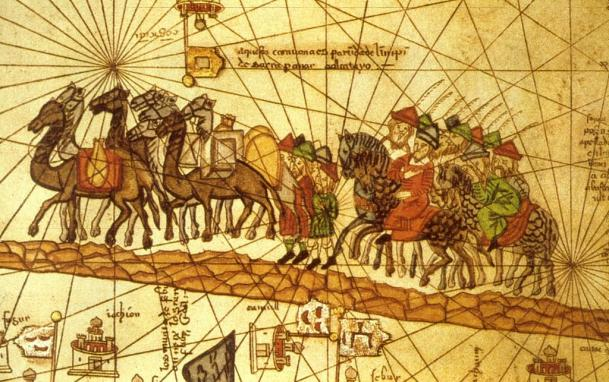
The Silk Road once served as a bridge between the economy, trade and culture of east and west. Animals are really an essential part of the history of the Silk Road. They played an important role in the Silk Road transportation.
Horses on the Silk Road
The horse, in ancient China, has always been a symbol of national vitality and strength. The most well-known example to illustrate the importance of the horse in the history of the Silk Road is the Mongol Empire. The Mongol horses, though not large, were strong and could survive in winter conditions because of their ability to find food under the ice and snow covering the steppes (大草原).
Camels on the Silk Road
Important as horses were, the camel was arguably of far greater significance in the history of the Silk Road. Bactrian camels with two humps (驼峰) and two coats of hair were commonly used on the Silk Road to carry goods. They could be employed in high mountains, cold steppes and deserts. Bactrian camels can go a week without water and a month without food. They can endure extreme hot and cold and travel long periods of time without water.
Caravans (大篷车) on the Silk Road
The process of travelling the Silk Roads developed along with the roads themselves. In the Middle Ages, caravans consisting of horses or camels were the standard means of transporting goods across land. Caravanserais, large guest houses or inns designed to welcome travelling merchants, played a vital role in facilitating the passage of people and goods along these routes. Found along the Silk Roads from Turkey to China, they provided not only a regular opportunity for merchants to eat well, rest and prepare themselves in safety for their onward journeys, and also to exchange goods, trade with local markets and buy local products, and to meet other merchant travelers, and in doing so, to exchange cultures, languages and ideas.
原创编写 版权所有 侵权必究! 每日更新 个性化阅读 英语飙升!
1.1. Which of the following statements about horses on the Silk Road is true?
A Mongol horses were large and powerful.
B Horses were the only means of transportation on the Silk Road.
C Horses were not as important as camels on the Silk Road.
D Mongol horses could endure cold and survive in winter.
解析:选D。D细节理解题。根据第二段的“The Mongol horses, though not large, were strong and could survive in winter conditions because of their ability to find food under the ice and snow covering the steppes.”可知,蒙古马虽然体型不算高大,但很强壮,能在冰天雪地中找到食物(耐寒),故而能在冬季生存。故选D。
2.2. From the third paragraph, we can know that ___________.
A camels were not used on the Silk Road
B bactrian camels could work in different conditions
C bactrian camels were only used in deserts
D camels were not that important in the transportation
解析:选B。细节理解题。根据第三段的“They can endure extreme hot and cold and travel long periods of time without water.”可知,双峰野骆驼能在高山、寒冷的雪地和沙漠等各种环境中生存。故选B。
3.3. What role did caravanserais play along the Silk Road?
A They provided protection for merchants only.
B They served as one of the means of transportation.
C They facilitated trade, cultural exchange, and rest for merchants.
D They produced goods for local markets.
解析:选C。细节理解题。根据第四段的“Caravanserais (商队驿站), large guest houses or inns designed to welcome travelling merchants ... and in doing so, to exchange cultures, languages and ideas”可知,商队驿站是商人休息和交易的场所,为旅途中的商人提供了必要的支持,还传播了文化和知识,促进了不同文明之间的交流与融合。故选C。
4.4. What is the main idea of the passage?
A The history of the Silk Road.
B The importance of animals in Silk Road transportation.
C Different types of animals used in ancient China.
D The cultural exchange along the Silk Road.
解析:选B。主旨大意题。文章主要讲述了马匹和骆驼这两种动物在古代的“丝绸之路”运输中的重要性。故选B。